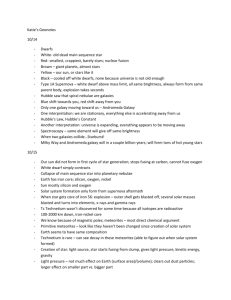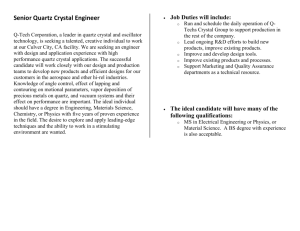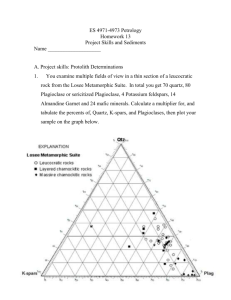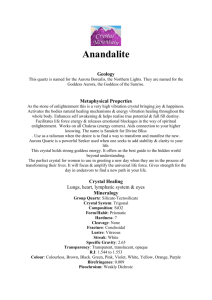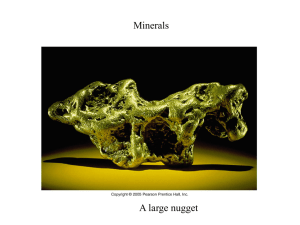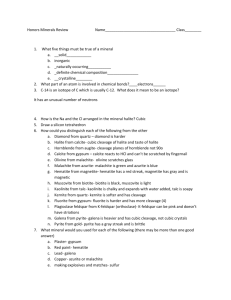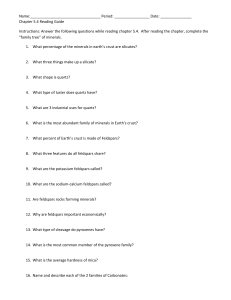Jessica Zhao - Cloudfront.net
advertisement
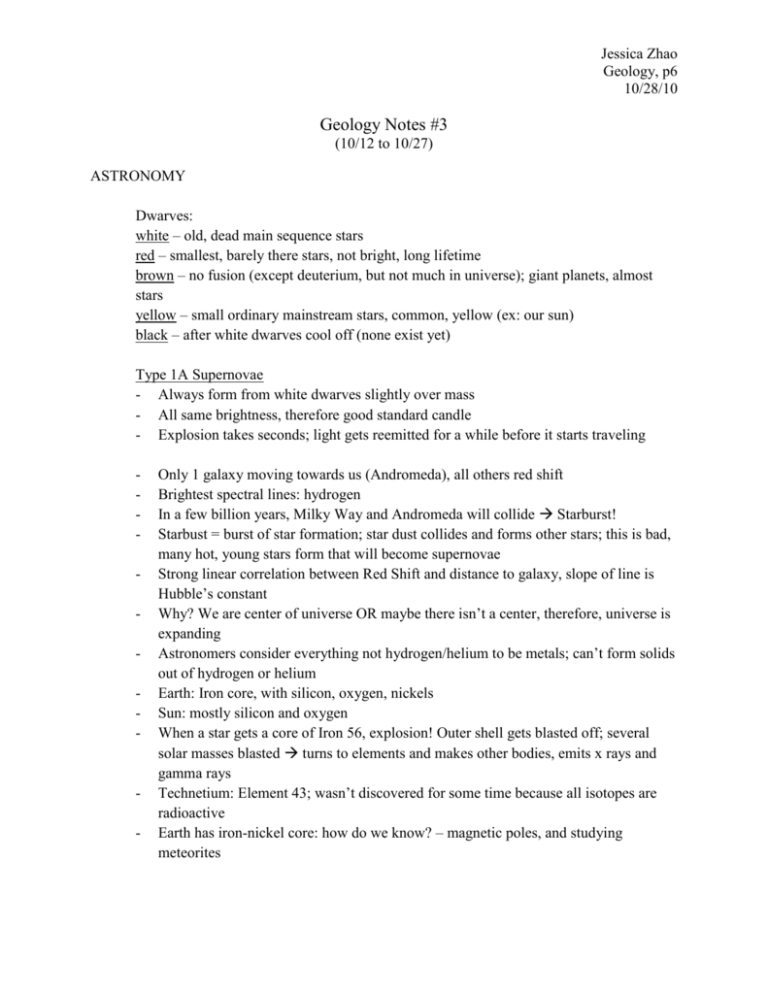
Jessica Zhao Geology, p6 10/28/10 Geology Notes #3 (10/12 to 10/27) ASTRONOMY Dwarves: white – old, dead main sequence stars red – smallest, barely there stars, not bright, long lifetime brown – no fusion (except deuterium, but not much in universe); giant planets, almost stars yellow – small ordinary mainstream stars, common, yellow (ex: our sun) black – after white dwarves cool off (none exist yet) Type 1A Supernovae - Always form from white dwarves slightly over mass - All same brightness, therefore good standard candle - Explosion takes seconds; light gets reemitted for a while before it starts traveling - - Only 1 galaxy moving towards us (Andromeda), all others red shift Brightest spectral lines: hydrogen In a few billion years, Milky Way and Andromeda will collide Starburst! Starbust = burst of star formation; star dust collides and forms other stars; this is bad, many hot, young stars form that will become supernovae Strong linear correlation between Red Shift and distance to galaxy, slope of line is Hubble’s constant Why? We are center of universe OR maybe there isn’t a center, therefore, universe is expanding Astronomers consider everything not hydrogen/helium to be metals; can’t form solids out of hydrogen or helium Earth: Iron core, with silicon, oxygen, nickels Sun: mostly silicon and oxygen When a star gets a core of Iron 56, explosion! Outer shell gets blasted off; several solar masses blasted turns to elements and makes other bodies, emits x rays and gamma rays Technetium: Element 43; wasn’t discovered for some time because all isotopes are radioactive Earth has iron-nickel core: how do we know? – magnetic poles, and studying meteorites - - - - - Primitive meteorites (Carbonaceous Chondrites) look like they haven’t been changed since creation of solar system (heated, cooled, etc); good example of raw solar system material; Earth has similar composition Technetium is rare, so in these meteorites we can study decay, therefore figure out age of solar system Creation of Star: star starts fusing from clump Light pressure: not much effect on earth Surface area/volume Clears out dust and particles Larger effect on small particles vs. big particles Dust blocks sight; dust absorbs light and reemits it as infrared Objects at normal temperature give off infrared, very difficult for ground based telescopes to distinguish from this and from space Technically, infinite time for dust to gather; but there’s a shock wave/compression wave that compresses gas, then that compresses more, etc Star formations usually occur in open clusters Our solar system probably formed from different supernovae, violent Temperature difference between inside and outside of solar system Volatility: how easy it is to vaporize Most volatile: CH4, N2 NH3 CO2 H2O alkali metal-rich silicates (1st column) other silicates/metals Refractory: opposite of volatile Earth is densest in solar system, mercury comes next Earth can’t hold helium, it goes into space; least renewable resource Beginning of Earth: NO helium; it comes from contamination of natural gas, radioactive decay of uranium Earth largest of terrestrial planets Critical size threshold that Earth did not reach to hold helium Saturn: ¼ of Jupiter Beginning of Earth: lots of molten rock, cools down, things calmed down Late Heavy Bombardment: bombardment of comets, asteroids, result of Jupiter screwing up everything possible there was life before, then destroyed Jupiter runaway mass; silicon and iron core; attracts many asteroids; large storms; metallic hydrogen forms most of composition - - Great Red Spot: cyclonic storm, much like a hurricane on Earth; has persisted for hundreds of years Red layers of ammonium Very recently, one of big stripes has vanished Saturation: when things are brighter in background (ex: hard to take picture when sun is in the background) Trapezium Cluster: (Theta Orionis), lit up by 4 bright stars in center; cluster of many extremely young bright stars that will turn supernova, these light/heat up surrounding gas Most nebulae mistaken for planets before because they all looked like fuzzy blue balls M57 – Ring Nebula: visible from LA, gives off layer of gas from dead star Cat’s Eye Nebula Eagle Nebula M42 – Orion Nebula; winter constellation, open cluster; in pictures, usually blurred because of nature of nebulae Probes 1. Solar-powered pro: perpetual, hard to break con: don’t get much power; also, less power as you go out further; dust 2. Thermo nucleic electronic generators - plutonium cores, leftover from Russia/Cold War supplies - heat generates electricity - Other rovers: meters per day; these can move a mile/ hour! – much faster than solar powered Con: unstable, not firmly established - - M1: Crab Nebula Written records from Chinese astronomers in 1054 that star blew up Really bright, can be seen during day Now remnants of supernova Light Echo: supernovae visible from existing gas today that’s traveling toward us Planetesimals: Mini-planets Things start sticking together by gravity, chemical reactions with ions Initially, process is insubstantial because they’re small objects As it gets larger, gravity increases, it generates heat (from explosions btwn objects that warms it) - Threshold when it starts melting metals Specific Density: How density compares to water’s density (1) Normal rocks have density of 2.5-3.5 Rock is easier to heat than water Energy for formation of Earth enough to kill Earth (which probably did happen) Molten Earth: dense stuff went down, other stuff went up Cool crust of basalt/silicate-ridge Metals sank down to core Top: least dense Differentiated body – sorted into layers If we find meteorites with crust material (basalt), it must have come from something larger (a differentiated body) Iron meteorites, pallicites (really pretty): sliced and cleaned, made into jewelry Earth’s core: all things rare at crust are here, like uranium, platinum, and other crazy metals Difficult to mine; alternative? – mine asteroids Related Words: Asteroid: A BIG rock in space Meteoroid: a random rock in space Meteor: shooting star; can be rock, sand, or solid something; falls through sky – fireball! usually burns up in atmosphere Meteorite: when a meteor is on the ground; rare because they’re hard to find; fraction of ironnickel meteorites rare (metal detectors); non iron-nickel ones are usually found in Sand Dunes (obvious) and Antarctica Comet: frozen mass that travels around the sun in a highly elliptical orbit Earth - Beginning, dry Earth (because of high temperature, things go to atmosphere, like water) Most water in oceans came from comet collisions Moon probably generated with giant collision between Earth and a Mars sized thing (10% mass of Earth), or 2 planet sized things ROCKS AND MINERALS Minerals vs. Rock - Mineral: 1. something with a fixed chemical composition/formula 2. Crystal structure 3. Naturally occurring - Rock: not really any formal definition; anything that’s hard (minerals are rock, by definition) - About 10-20 minerals that make up most rocks; people discover new minerals that are microscopic Examples: Granite: easy to pick out minerals, course-grained Quartzite: whitish, made only out of 1 mineral (quartz) Marble and Chalk: both made out of single mineral (calcite), but they don’t behave the same way, not formed the same way Obsidian: volcanic glass; it’s a rock but not made of minerals - glass is not a mineral because no crystalline structure (it is amorphous) Basic properties of minerals 1. Chemical Formula 2. Naturally occurring 3. Crystal structure: different geometric shapes (cubes, hexagons) - if you let something grow without interference, it will have clear, geometric shapes of crystals, with crystal faces different shapes called crystal habit: the ideal geometric shape it’ll take on but, usually not ideal conditions; the grains aren’t perfect because of external factors thus, perfect crystals = $$$ diamonds formed with pressure on carbon; CVD (Chemical Vapor Deposition) can artificially make perfect diamonds, rubies, emeralds, etc. but NOT alexandrite (different colors from various angles) Crystal Faces: perfects, smooth surfaces Examples: Watermelon Tourmalline: results from subtle changes in trace ions Other distinctive traits: color, crystal habit, hardness, cleavage/fracture, lustre, streak Hardness: - Based on if one mineral can scratch the other Mohs Hardness Scale (German) 1- Talc (soft, common, in baby powder) 2- Gypsum (raw component in plaster, drywall) [Fingernails] 3- Calcite (most common) 4- Fluorite (pretty crystals, main ore of fluorine) 5- Apatite (usually microscopic, main ore of phosphorus) [Typical steel, like knives] 6- Orthoclase (Pink stuff in granite) 7- Quartz 8- Topaz 9- Corundum 10- Diamond Quartz - 7 trace contaminants make different colors smoky quartz: radiation damage pure quartz is opaque (can’t see through it), because light refracts off hardest common mineral things with 7 and above difficult to scratch most watches have a synthetic sapphire glass easy to confuse gypsum/calcite, but use fingernails to scratch gypsum Calcite vs. Quartz: use knife Corundum: name for many gemstones, but just different colors 99.9% same chemical composition Most sapphires are light blue (barely) Most deep blue sapphires are rare, and artificial ones are made through heat Star Sapphires: light shines for star pattern, RARE = $$$ Cleavage: - Based on chemical structure, determines which direction mineral is more likely to break - Characterized also by angels cleavage planes form at - Not everything has cleavage planes - Generally, there are 3 (like calcite) - Mica: flat, shiny, sparkly; obvious cleavage as it breaks into thin sheets; across, it has strong covalent bonds, but different layers have weak hydrogen bonds - Crystal faces are often mistaken for cleavage planes - Calcite: rhombonedian cleavage; under microscope it has parallel grains - If no cleavage planes, will fracture irregularly Luster: - Least quantitative, most useful - Visual texture of something, how it reflects light - Common lusters: Glassy/vitreous, Metallic (like pyrite), Waxy, Drusy, resinous, Silky, Pearly (opal) - Conchoidal fractures: curved lines; ideal: obsidian (rapid cooling of high silica magma), can tap out cones and break it into ways you want it Granite: Quartz: gray, no cleavage, had conchoidal fractures, Hardness 7 if pure, a grayish-white, clear if one big crystal SiO2 really resistant to destructive environments (will just break into pieces); physically/chemically durable orange is contamination of ion oxide lots in sedimentary rocks Cryptocrystalline quartz: “secret quartz,” individual grains/crystals are microscopic; like agate, jasper, and chert (all flint) Noncryptocrystalline quartz: primarily classified by color Feldspar - Widmanstatten (iron nickel), meteorite rings Martian meteorites (most are from asteroids) Mars meteorites form from large asteroids/huge impacts that knock away rocks parts: heated surface (smooth), and cut off parts coming in at 10 km/s Difficult to find: thick layer outside of melted rocks looks exactly like a microbial coating that forms over rocks that are outside (in desert, called desert varnish) Iceland Spar: really pretty, clear calcite; has biofringing, where light rays refract 2 images Examples: Benitoite: state gemstone, really rare, found in CA and Siberia Hornblende: trapezoidal cleavage, 56 degree angle Quartz crystals: at end, called termination, mostly not broken surfaces, but grows with edges in ideal conditions; if broken, there are no parallel breaks, are conchoidal fractures Agate: banded cryptocrystalline quartz, commonly reddish brown (hematite), other contaminants cause color to change Geodes: agate in which as you go towards the center, there are larger quartz crystals; the center is hollow Rose quartz (pink) Amethyst (purple) Citrine (Yellow) Ametrine (Purple) Aventurine (looks like jade) Chalcedony (color free cryptocrystalline quartz)

